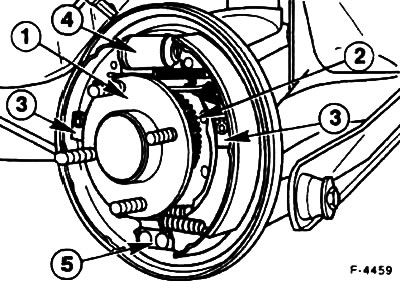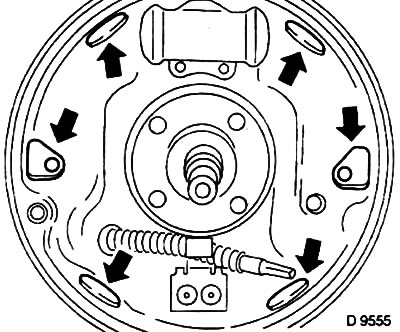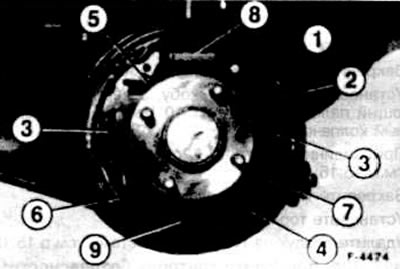Withdrawal
Attention! Essentially replace all pads on one axle, even if only one pad is worn or oily.
Mark the position of the wheels on the hub with paint in order to install them in their original place during assembly. Loosen the wheel nuts with the vehicle lowered. Raise the rear of the car and remove the rear wheels.
Release the parking brake.
If necessary, use a small screwdriver to remove the two stoppers from the wheel studs.
Remove the brake drum.

Attention! If the brake drum cannot be removed, compress the pads. To do this, remove the plug from the hole on the rear side of the caliper and press with a small screwdriver on the cam of the adjustment lock -arrow- forward in the direction of travel. In this way, automatic adjustment of the brake shoes is eliminated, and they converge under the influence of the coupling springs.

Pull down the two pressure springs -3-.
Disconnect the tension springs.
Attention! Before removing the brake pads, it is recommended to mark the position of the return springs and thrust plate, mark the springs with adhesive tape to facilitate subsequent assembly.
Remove both chocks from the wheel cylinder -4-, taking care not to damage the dust caps. Remove the blocks from the lower support -5-.
Attention! When removing the pads from the brake cylinder, make sure that the pistons do not come out of the cylinder. If necessary, secure the pistons with a rubber ring to keep them in the cylinder.

Rotate the rear brake shoe 90°and disconnect the parking brake cable from the shoe lever.
Installation
Essentially replace all four pads, install pads from the same manufacturer. Blow out the brake drum and caliper with compressed air or clean with alcohol.
Attention! Do not inhale harmful brake dust. With the brake pads removed, do not press the brake pedal, as the pistons will fall out of the wheel cylinder. If the brake cylinder is wet with brake fluid, it must be replaced.
Check the working surface of the drum with your finger for the absence of grooves and protrusions. Replace a drum that has an uneven working surface, in this case, in principle, replace both drums.

Clean the six contact surfaces of the caliper with the brake pads and lubricate them with a thin layer of heated grease, such as Thermopaul 1, before installing the pads. Clean these areas, if necessary, with a soft metal brush before applying the grease.
Connect the parking brake cable to the rear shoe lever.

Install the rear brake shoe -7-
Install thrust plate -5- and attach upper coupling springs -1/2-.
Install the front brake shoe -6- into the groove of the thrust plate, into the wheel cylinder -8-, stop -9- and press against the brake caliper.
Attention! When installing the pads, do not damage the dust seals of the wheel cylinder.
Press the rear brake pad against the caliper. Secure with a clamp if necessary.
Insert the pin of the rear shoe holder from the inside and insert the spring stopper -3-. Compress the spring and rotate it 90°around the pin, keeping the pin from turning from the rear. Release the spring to lock the pin into place.
Attach the tension springs.
Press the front pad against the caliper, secure with a clamp if necessary.
Insert the holder pin from the inside and insert the spring stop. Compress the spring and rotate it 90°around the pin, keeping the pin from turning from the rear. Release the spring to lock the pin into place.
Remove, if used, clamp.
Remove, if used, the rubber ring to hold the pistons in the wheel cylinder.
Install the brake drum and fix it, if necessary, with two stoppers, putting them on the threads of the two opposite wheel studs.
Install the rear wheels so that the previously made marks match. Before installing the wheels, lubricate the centering surface on the wheel hub with a thin layer of grease. Screw on the wheel nuts. Lower the vehicle and tighten the nuts crosswise to 100 Nm.
Depress the brake pedal several times to center the brake pads.
Visitor comments